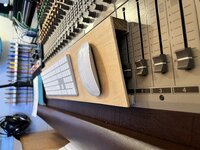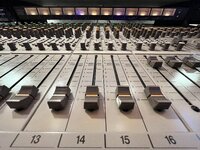maurice.marion
New member
Update: I've gotten the unit to work! I'm able to run signal through all 16 channels and route them to buses 7-8 which feeds to the stereo out, and the EQs all work. Sounds great. Feel free to ignore my previous two posts (unless of course there's something in either of them you particularly want to respond to.)
Basically the issue was that I jumped the gun on patching everything up with the buses and the patchbays before making sure the basic routing worked with all the jumpers in exactly right. I should've known better and started with the basics first .
.
My two remaining issues:
Basically the issue was that I jumped the gun on patching everything up with the buses and the patchbays before making sure the basic routing worked with all the jumpers in exactly right. I should've known better and started with the basics first
My two remaining issues:
- I'm getting this persistent buzz out of the stereo master A output (also get the same buzz when I directly route the output out of PGM buses 7-8). File attached to show it. It's not a problem during louder sections of songs honestly, but it can definitely be heard during quieter sections, and it's not a cool vibey hiss or anything like that but a pretty ugly buzz. Any idea where that might be coming from/what might be some steps to troubleshoot or resolve it?
- I'd love to resolve my remaining question about trying to do parallel compression if I can... I was messing around a bit and I do see that I can separately route, say, some stereo vocals to both buses 5-6 and buses 7-8 simultaneously and both end up going out of the output of the Stereo Master A. So why not just run the SNDs of buses 5-6 into an outboard stereo compressor and run the output of the compressor back into the RCVs of the buses 5-6, so now both the compressed vocal and the uncompressed vocal are going to the stereo master output? Am I missing something there? Seems straightforward, no?
Last edited:




